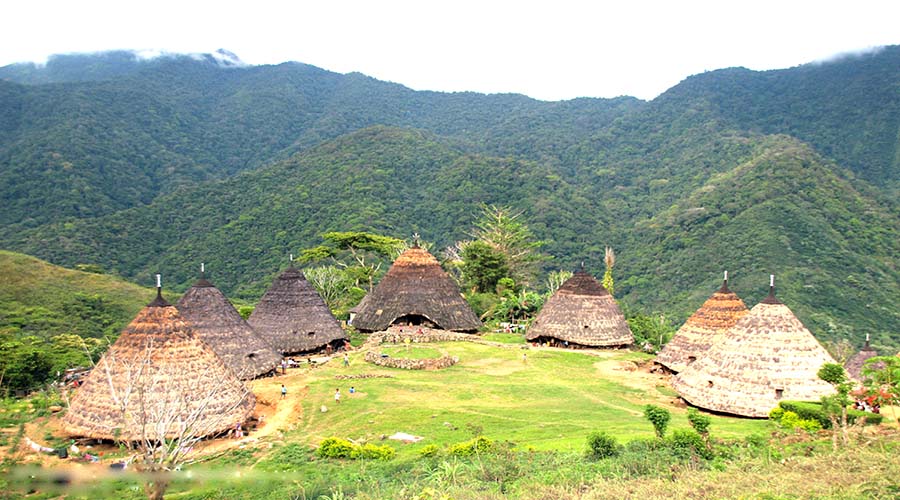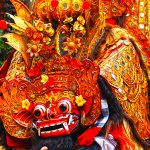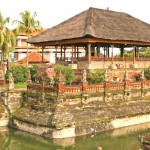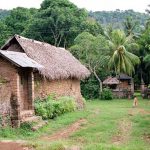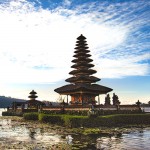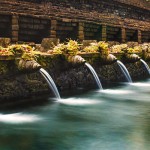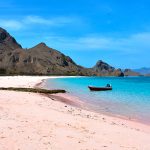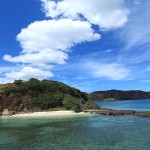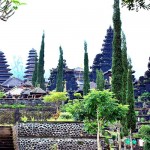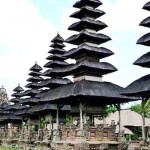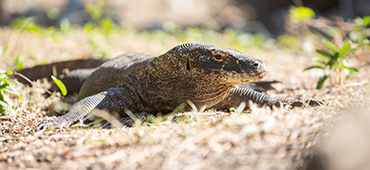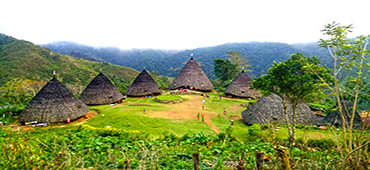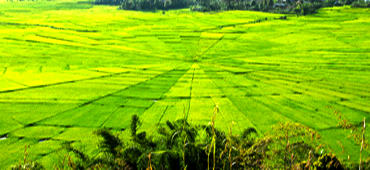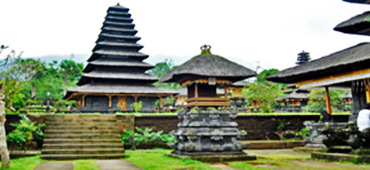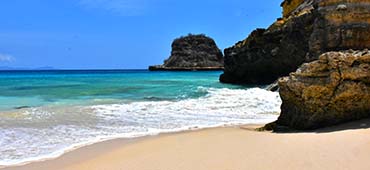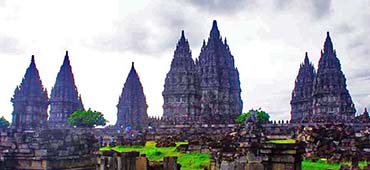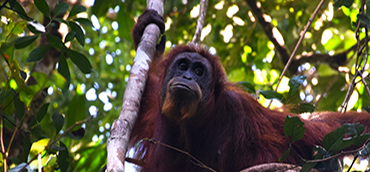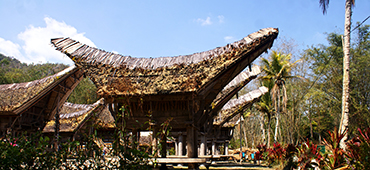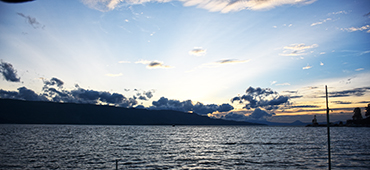Wae Rebo is a beautiful and amazing village, covered by a thin mist throughout the township makes Wae Rebo deserves the epithet ‘village above the clouds’. Geographically the village is situated above an altitude of 1,200 meters above sea level (m asl). Wae Rebo is part of the Village Satar Lenda, District Satarmese, West Manggarai regency, Flores.
The Visitors have the opportunity to see and live in Mbaru Niang, a Flores remaining Traditional House and only exist in Wae Rebo village. In 2012, Mbaru Niang Waerebo received an award from UNESCO. The natural landscape of green hills and forests that is still beautiful, with shrouded by mist that sometimes uncovered by the wind, exposing seven Mbaru Niang standing majestically, it is like a view of the tub in a fantasy land.
Wae Rebo is inhabited by 112 heads of household, or around 625 inhabitants (2012 data) which is also another things to know especially for the visitors from overseas. It is undeniable that in addition to the cost factor that is relatively expensive to get to this place, the journey itself is an experience, adventure and challenge. Out of your curiosity to know about Mbaru Niang, The Atmosphere of Wae Rebo that is isolated from the bustle of the city is also the main attraction for Visitors.
Local Culture which is still depend on the nature is another most interesting thing when we visit Wae Rebo village. One of the local wisdom that still exist is to preserve Mbaru Niang. In Wae Rebo itself there should only be seven Mbaru Niang nothing less and nothing more. One house can be occupied by six to eight families. The rest of the community who are not accommodated in Wae Rebo had to move to the village Kombo, a village located approximately five kilometres from Wae Rebo who later earned the nickname twinning Wae Rebo village because most of the villagers are from Wae Rebo.
Wae Rebo is located in the Southwestern town of Ruteng, the capital of Manggarai regency, Flores, East Nusa Tenggara. However given access to air transport, it would be easier if the journey starts from Labuan Bajo. From several sources, most visitors take a circuitous route to the village of Ruteng before Denge which is the last village before heading Wae Rebo village. During the long journey to the village Denge we are treated to incredible views, a paddy field of Flores fertile soil, road hill climb and seductive views of the coastline.
Denge is a coastal village located on the beach front. Denge plays a role as a transit place for the visitors before travelling to Wae Rebo. Here there are several home stay which is managed by the residents of Denge and Wae Rebo. Usually before travelling to Wae Rebo, the visitors will have a Rest in Denge after a long trip from Labuan Bajo or Ruteng. Denge village is the last village traversed by vehicles, a motorcycle or a car. To get to Wae Rebo, we must walk. To facilitate the visitors, many Youth from Denge village and Wae Rebo is willing to be a porter, help visitors carry their equipment when trekking to Wae Rebo. The Walking will start from the premises Denge ± 9 km distance which can be reached within 2-4 hours, highly dependent physical condition of each visitor. Due to Denge village lies exactly on the beach, you could say the trip to Wae Rebo starting from the point 0 m above sea level and climbing mountains to a height of 1,200 m above sea level. These are the beginning of wide dirt roads that are likely to be made asphalt. We walk through a lush forest. On entering the forest, visitors will be greeted by the noisy sound of birds song. The forest in this region is the common area, which is a location that became the meeting place every member of society. No wonder that during a trip through the jungle, we will often meet with community members who are taking forest things and bring it to families in Kombo or Denge, or just visiting relative. The Route is a circular route through the hills that prone to landslides and road narrowing. Hiking with a variety of difficulty levels is a challenge to visitors. Hiking is the toughest path between Denge to Wae Lumba. This path is characterized by large rocks, often uphill and sometimes slippery. Additionally we would pass a small river before arriving at Wae Lumba.
The Route from Wae Lumba to Poco Roko is also a big challenge, especially for people who are afraid of heights. Visitors go down a path on the brink. Poco Roko is the highest point and the location where people come into contact with modernization, here is normally resident looking for phone signals. With the phone signal means of communication with the outside world could happen. One of the visitors said they had to update the status on one of the social networks while in Poco Roko.
A few minutes after passing Poco Roko, we will arrive at Ponto Nao. Here there is a monitoring post with a roof made of palm fiber, the same as the material used to make the roof of traditional House Mbaru Niang and from Ponto Nao we can see in the distance a village with buildings conical steaming; The village above the clouds, Wae Rebo. Walking downhill with an overlay of coffee plants along the road until arriving at the village gate Wae Rebo.
Wae Rebo is an old traditional village of Manggarai that is still exists to preserve local wisdom as one of the cultural richness of Indonesia. One of the ritual is Pa’u Wae Lu’u. This ritual is led by one of the elders of Wae Rebo which aims to get permission and protection from the ancestral spirits of the guests who visit and live in Wae Rebo until they leave this village. Not only that, the ritual is also devoted to the visitor when it had reached in their home areas. For the people of Wae Rebo, the visitor who come there has been regarded as a brother who was returning home. Before the completion of this ritual, guests are not allowed to conduct any activities, including taking indigenous photo. The Leader of Wae Rebo will then perform a small briefing about some taboo which not to be done by the guests during their stay in Wae Rebo, Such as the women are not allowed to wear tank tops or hot pant as it will make citizens become uncomfortable. Another thing that needs attention is not showing affection, be it with the opposite sex or kind, such as holding hands, hugging or kissing, even husband and wife. Another thing to avoid is cursing or swearing while in this village. Visitors are also required to release the footwear when entering into other local House. Indeed, there is an impression that the administration costs are always associated with the commercialisation of culture, money and other questions that are always associated with corruption. But money in Wae Rebo administration is regulated by local wisdom. All the Donations are managed by the Institute of Tourism Wae Rebo. Administration fee obtained from the rating used for the cost of groceries and cooking food made by mothers, village infrastructure maintenance, fuel generator sets and Water sources. Daily life of Residents of Wae Rebo is coffee farmers and currently citizens of Wae Rebo is developing vegetable gardening.
For Visitorss who come to participate in the event, such as participating the activities in front of the house. The Visitors can be directly involved in the daily activities of Wae Rebo community. At night, the visitors will stay at Mbaru Niang, custom home Wae Rebo whose name is worldwide. With mats woven from panda-nus leaves, we will mingle and share stories about life experiences large family in Wae Rebo.

